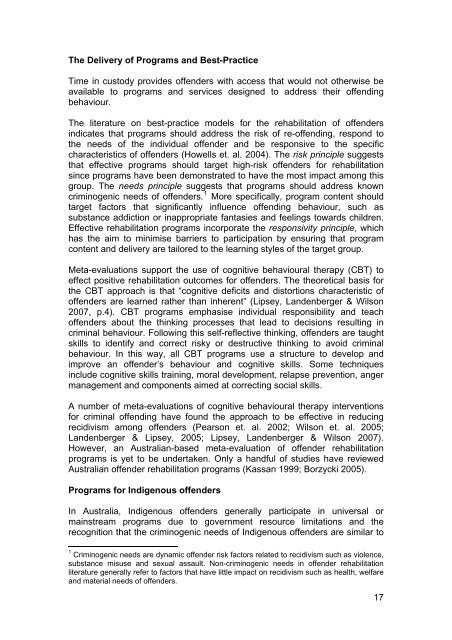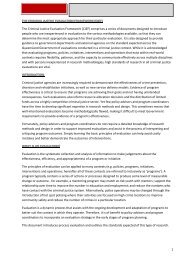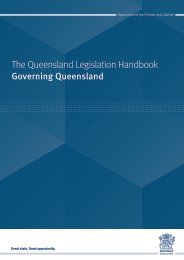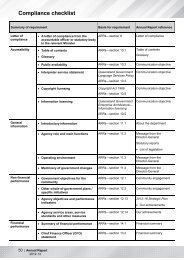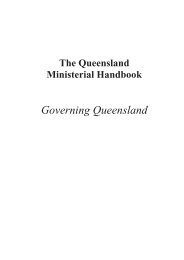Rehabilitative needs and treatment of Indigenous offenders in ...
Rehabilitative needs and treatment of Indigenous offenders in ...
Rehabilitative needs and treatment of Indigenous offenders in ...
You also want an ePaper? Increase the reach of your titles
YUMPU automatically turns print PDFs into web optimized ePapers that Google loves.
The Delivery <strong>of</strong> Programs <strong>and</strong> Best-PracticeTime <strong>in</strong> custody provides <strong>of</strong>fenders with access that would not otherwise beavailable to programs <strong>and</strong> services designed to address their <strong>of</strong>fend<strong>in</strong>gbehaviour.The literature on best-practice models for the rehabilitation <strong>of</strong> <strong>of</strong>fenders<strong>in</strong>dicates that programs should address the risk <strong>of</strong> re-<strong>of</strong>fend<strong>in</strong>g, respond tothe <strong>needs</strong> <strong>of</strong> the <strong>in</strong>dividual <strong>of</strong>fender <strong>and</strong> be responsive to the specificcharacteristics <strong>of</strong> <strong>of</strong>fenders (Howells et. al. 2004). The risk pr<strong>in</strong>ciple suggeststhat effective programs should target high-risk <strong>of</strong>fenders for rehabilitations<strong>in</strong>ce programs have been demonstrated to have the most impact among thisgroup. The <strong>needs</strong> pr<strong>in</strong>ciple suggests that programs should address knowncrim<strong>in</strong>ogenic <strong>needs</strong> <strong>of</strong> <strong>of</strong>fenders. 1 More specifically, program content shouldtarget factors that significantly <strong>in</strong>fluence <strong>of</strong>fend<strong>in</strong>g behaviour, such assubstance addiction or <strong>in</strong>appropriate fantasies <strong>and</strong> feel<strong>in</strong>gs towards children.Effective rehabilitation programs <strong>in</strong>corporate the responsivity pr<strong>in</strong>ciple, whichhas the aim to m<strong>in</strong>imise barriers to participation by ensur<strong>in</strong>g that programcontent <strong>and</strong> delivery are tailored to the learn<strong>in</strong>g styles <strong>of</strong> the target group.Meta-evaluations support the use <strong>of</strong> cognitive behavioural therapy (CBT) toeffect positive rehabilitation outcomes for <strong>of</strong>fenders. The theoretical basis forthe CBT approach is that “cognitive deficits <strong>and</strong> distortions characteristic <strong>of</strong><strong>of</strong>fenders are learned rather than <strong>in</strong>herent” (Lipsey, L<strong>and</strong>enberger & Wilson2007, p.4). CBT programs emphasise <strong>in</strong>dividual responsibility <strong>and</strong> teach<strong>of</strong>fenders about the th<strong>in</strong>k<strong>in</strong>g processes that lead to decisions result<strong>in</strong>g <strong>in</strong>crim<strong>in</strong>al behaviour. Follow<strong>in</strong>g this self-reflective th<strong>in</strong>k<strong>in</strong>g, <strong>of</strong>fenders are taughtskills to identify <strong>and</strong> correct risky or destructive th<strong>in</strong>k<strong>in</strong>g to avoid crim<strong>in</strong>albehaviour. In this way, all CBT programs use a structure to develop <strong>and</strong>improve an <strong>of</strong>fender’s behaviour <strong>and</strong> cognitive skills. Some techniques<strong>in</strong>clude cognitive skills tra<strong>in</strong><strong>in</strong>g, moral development, relapse prevention, angermanagement <strong>and</strong> components aimed at correct<strong>in</strong>g social skills.A number <strong>of</strong> meta-evaluations <strong>of</strong> cognitive behavioural therapy <strong>in</strong>terventionsfor crim<strong>in</strong>al <strong>of</strong>fend<strong>in</strong>g have found the approach to be effective <strong>in</strong> reduc<strong>in</strong>grecidivism among <strong>of</strong>fenders (Pearson et. al. 2002; Wilson et. al. 2005;L<strong>and</strong>enberger & Lipsey, 2005; Lipsey, L<strong>and</strong>enberger & Wilson 2007).However, an Australian-based meta-evaluation <strong>of</strong> <strong>of</strong>fender rehabilitationprograms is yet to be undertaken. Only a h<strong>and</strong>ful <strong>of</strong> studies have reviewedAustralian <strong>of</strong>fender rehabilitation programs (Kassan 1999; Borzycki 2005).Programs for <strong>Indigenous</strong> <strong>of</strong>fendersIn Australia, <strong>Indigenous</strong> <strong>of</strong>fenders generally participate <strong>in</strong> universal orma<strong>in</strong>stream programs due to government resource limitations <strong>and</strong> therecognition that the crim<strong>in</strong>ogenic <strong>needs</strong> <strong>of</strong> <strong>Indigenous</strong> <strong>of</strong>fenders are similar to1 Crim<strong>in</strong>ogenic <strong>needs</strong> are dynamic <strong>of</strong>fender risk factors related to recidivism such as violence,substance misuse <strong>and</strong> sexual assault. Non-crim<strong>in</strong>ogenic <strong>needs</strong> <strong>in</strong> <strong>of</strong>fender rehabilitationliterature generally refer to factors that have little impact on recidivism such as health, welfare<strong>and</strong> material <strong>needs</strong> <strong>of</strong> <strong>of</strong>fenders.17


